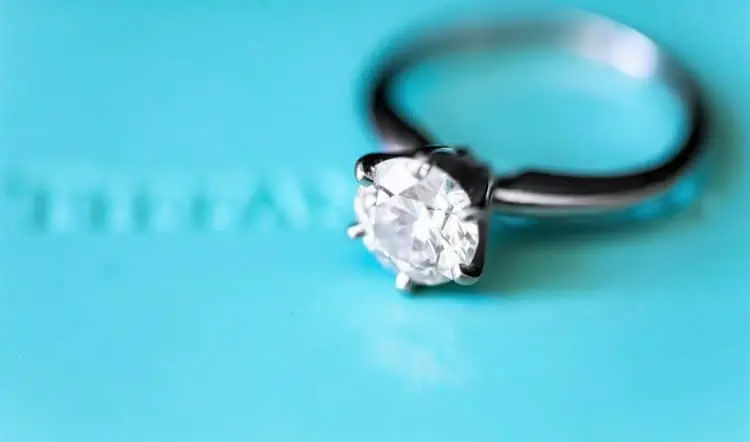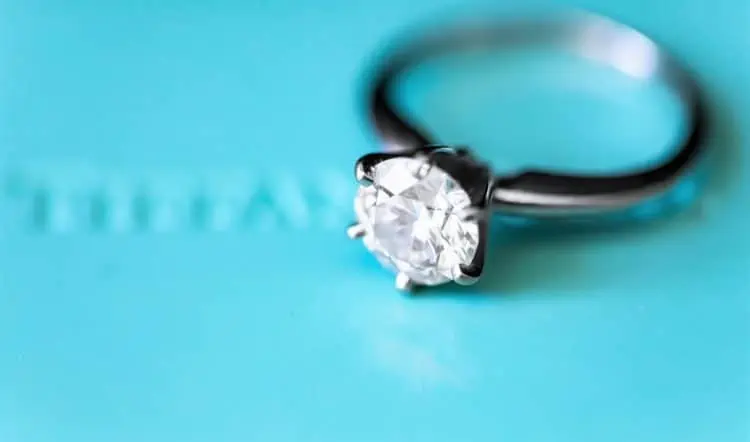Congratulations!
If you’re reading this post, you’ve likely found the person you want to spend the rest of your life with. Perhaps you’re considering popping the question to your partner soon, or you’re just starting to research the cost of an engagement ring so you can begin saving up.
No matter what brought you here, this post will share everything you need to know about buying an engagement ring. We cover how much you should spend on an engagement ring, how to save up to pay for the ring, creative ways to reduce the cost if budget is an issue, and determining the best style to purchase for your partner.
Look at buying your engagement ring as part of the process of planning a stress-free wedding.
How to Save Money on Engagement Rings
Why The Two Months’ Salary Rule is BS
Have you heard that a good rule of thumb for what you should spend on an engagement ring is to pay the equivalent of two months’ salary? We’re not exactly sure where this figure came from, but feel free to ignore it.
Similar to the reported “average” wedding budgets shared by the mainstream media, they promote this to convince the public that they should spend a certain amount. Who seeks to gain from spreading these reports? The jewelers and diamond companies, of course!
So how much should you spend on an engagement ring? First, you should consider what you can afford as well as the style of ring your partner will love. The key is to strike a balance between those two areas of consideration.
Everyone’s financial situation is different, as are their stylistic tastes, and their longterm goals and priorities. You’ll need to reconcile all of these to choose the best ring to purchase for your partner when you pop the question.
Take a look at your monthly budget and your current savings. How much could you put towards a ring right now? How much could you save up each month to put towards the ring? Then, factor in those monthly payments when combined with your current savings. How long will it take you to save up to pay for the ring of your partner’s dreams in cash?
Don’t forget, after the proposal; you’ll have to save up to pay for a wedding as well. Don’t put yourself into debt or in a financial pinch to buy a ring you can’t afford.
How to Buy an Affordable Engagement Ring
If you want to make sure you buy a unique engagement ring that your partner loves while also staying within your financial means, it will take research, intel, and dedication. Below, we’ll outline the details of how to go about choosing the perfect engagement ring and making sure you get the best price.
Why Do Engagement Rings Cost so Much?
In modern times, engagement rings have become synonymous with diamonds, thanks to a popular ad campaign from De Beers in the 1940s: “A Diamond is Forever.”
In many ways, it was a brilliant campaign designed to increase the sales of diamonds due to a steep decline during the Great Depression. This smart marketing campaign created an emotional link between eternal love and the diamond, which has become the gold standard for engagement rings ever since.
And why are diamonds themselves so expensive? What makes a diamond so valuable?
Diamonds were historically quite hard to find, which made them appear to be rare, and therefore more valuable. De Beers had a hand in the rarity of diamonds as well by purchasing the largest diamond mining area in South Africa, which they controlled for most of the 19th century. The company restricted the number of stones released each year to keep the illusion of limited supply to make them appear rarer.
In recent decades, a broader global supply has been revealed as new mines opened around the world, as well as the increasing popularity of lab-created diamonds. Several factors contribute to the cost of diamonds today.
Luckily, we also have more choices when it comes to sourcing stones, so you don’t have to worry as much about falling prey to marketing tactics or scarcity sales messages.
The Four C’s of Diamonds that Factor the Cost
If you’re wondering what you should look for when you purchase a diamond engagement ring, you can start by considering the Four C’s of diamonds. The GIA has defined these characteristics to standardize the valuation of diamonds.
The goal is to keep things ethical and fair. The following four facets contribute to the cost of a particular stone:
1. Carat
Carat refers to the apparent size of a diamond and is just one of the contributing factors of a diamond’s cost. A carat is 200 milligrams. Each carat gets broken down into 100 points. The reported average diamond in an engagement ring is around one full carat, for around $6,000 in cost.
2. Clarity
Clarity refers to the gemstone’s overall quality. A flawless diamond is free from visible inclusions, surface defects, or blemishes. Most diamonds, however, do have small inclusions or imperfections that are microscopic, meaning they are entirely incapable of being seen with the naked eye. Saving experts say clarity is the least important factor when choosing a diamond because of this fact.
3. Color
Diamond color refers to the actual visual tone of the stone and is graded on a scale of D (colorless) through Z (light color.) While fancy colored diamonds such as pinks, yellows, and blues are considered rare and desirable, clear diamonds are most popular for engagement rings. The more clear in color a diamond is, the more valuable it will be. Diamonds with a slightly yellowed hue are considered less desirable and therefore tend to be cheaper.
4. Cut
The cut of a diamond refers to the shape and technique used to shape the diamond into its’ final state. There are many different popular cuts for a diamond, such as round, brilliant, princess, oval, cushion, emerald, Asscher, marquis, pear, and more. Round is the most popular shape for a center diamond, by far, followed by a princess.
5. Creation (The Fifth C)
Is the diamond mined from the earth, or was it created in a lab?
Lab-grown diamonds have skyrocketed in popularity in recent years. Not only are they genetically the same material as traditionally earth-mined diamonds, but they are also conflict-free and more affordable as well. Choosing a lab-grown diamond over a mined stone can save you 30%, so it’s a bit of a no-brainer.
You could decide to save 30% on a stone of the same quality as a traditionally mined rock, or you can make your money go farther. You could choose a larger or higher quality stone for the same spend as you’d pay for an earth-mined stone.
Other Cost Factors in an Engagement Ring
The other major factor in the cost of an engagement ring is the setting. Once you’ve chosen your diamond (or another gemstone), you’ll need to decide how you would like that stone presented.
There are more designs than ever to choose from these days, from simple solitaires set in white gold to micropavé halo bands with tiny diamonds covering the entire ring. The setting for your engagement ring could ultimately cost more than your center diamond, depending on what you choose.
Tips to Save Money on an Engagement Ring
If you’re on a tight budget, you may be looking for ideas on how to reduce the costs of an engagement ring. Below are some tips that will help you find a beautiful piece for your partner while keeping your spending in check.
#1 – Select a Low Clarity Stone
Opt for a stone that is lower in clarity. As mentioned above, internal inclusions and imperfections are usually untraceable with the naked eye and could only be seen under a microscope.
Choosing an internally flawless diamond will cost you more, or perhaps push you to select a smaller stone to afford that level of clarity. By selecting a stone with a lower clarity rating, you will likely be able to afford a larger stone.
#2 – Choose a Diamond Alternative
If diamonds are too spendy for you, perhaps you’d instead consider a diamond alternative such as Moissanite, which is made from silicon carbide crystal.
You could also go wholly non-traditional and opt for a colored gemstone if your partner would love something a bit more unique.
#3 – Consider a Lab-Grown Diamond
As mentioned above, Lab-grown diamonds will save you 30% or more when compared with naturally mined diamonds with similar specifications. For that reason, lab-created diamonds are a very budget-savvy choice. Many consider them to be a more eco-friendly option for a wedding or engagement ring, as they are less harmful to the earth when created in a lab.
#4 – Select a Simple Setting
Keep the cost of your engagement ring down by selecting a simple setting for your diamond. Consider a single solitaire on a white gold band for the most cost-effective and traditional solution.
#5 – Go for Gold over Platinum
Platinum gained popularity in recent years for being the top choice for an engagement ring or wedding band, but truthfully the metal is not as durable as gold, and it is also more expensive. You’ll save significantly by choosing to set your rings in 14k white gold.
#6 – Shop Online for Better Selection
Choose a reputable online retailer to find the best quality diamonds and engagement rings at the best prices. They have lower overhead and pass along the cost savings to their customers.
Just make sure to shop with a retailer that will provide you with a certificate of authenticity for your diamonds.
In Conclusion
Whether you’re close to popping the question or just starting to save up for your sparkler, we hope this post has given you some great insights and ideas into buying an engagement ring. Best of luck and happy proposing!
This article originally appeared on The Money Mix and has been republished with permission.
Jessica Bishop is the founder of The Budget Savvy Bride, an extensive online resource to help couples plan a beautiful wedding they’re proud of on a budget they can actually afford. Jessica has shared her money-saving tips and planning advice with outlets such as GMA, BRIDES, Refinery 29, Glamour, Cosmopolitan, Huffington Post and more.

